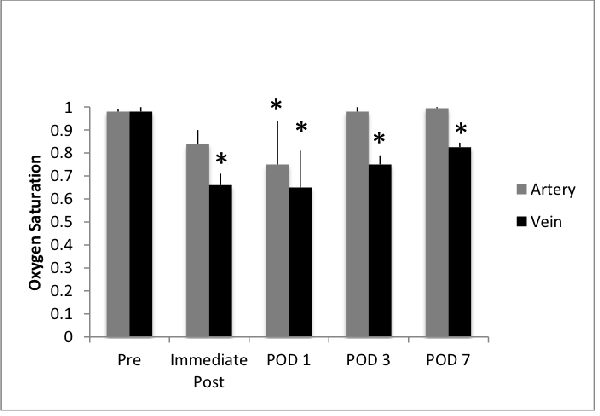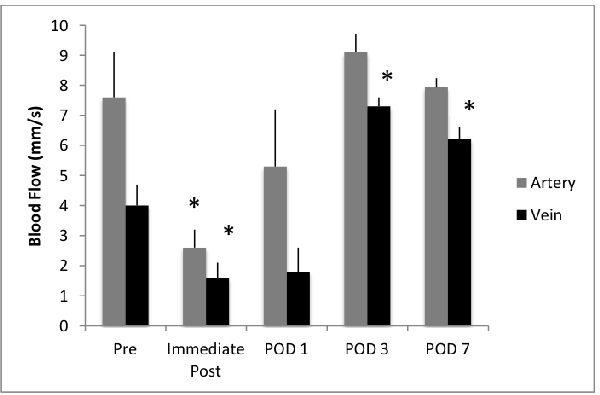|
Back to Annual Meeting Program
Hypoxic Recovery Following Massive Small Bowel Resection As Measured by Photoacoustic Microscopy
Kathryn J. Rowland*1, Junjie Yao2, Lidai Wang2, Christopher R. Erwin1, Lihong Wang2, Brad Warner1
1Pediatric Surgery, Washington University in St Louis School of Medicine, St Louis, MO; 2Biomedical Engineering, Washington University in St Louis, St Louis, MO
Purpose: Massive small bowel resection (SBR) results in an adaptive response within the remnant bowel and is associated with villus angiogenesis. Using optical-resolution photoacoustic microscopy (OR-PAM), a non-invasive, label-free, high-resolution hybrid in vivo imaging modality, we have recently demonstrated an immediate (within 10 minutes) reduction in both intestinal blood flow and arterial and venous oxygen saturation (sO2) after SBR. The present study sought to determine the duration of resection-induced intestinal hemodynamic alterations.
Methods: OR-PAM was used to record vessel diameter, blood flow, and sO2 of the terminal mesenteric arteriole and accompanying vein within the intestinal wall of C57B6 mice following a 50% proximal SBR. Measurements were taken on post-operative day (POD) 1 (n=3), POD 3 (n=3), and POD 7 (n=6) and compared to pre-operative values (n=7) and immediately following SBR (10 minutes; n=7). All measurements were made 6 cm proximal to the ileocecal junction and are presented as mean ±SE. A p value ≤ 0.05 was considered significant.
Results: Arterial and venous sO2 dropped immediately following SBR, as demonstrated in Figure 1. Compared with pre-operative values, significantly lower arterial and venous sO2 measurements persisted on POD1. By POD3, the arterial sO2 recovered to pre-operative values, however venous sO2 remained significantly lower than pre-operative values. This low venous sO2 persisted on POD7. Arterial and venous blood flow decreased significantly immediately post-SBR, as demonstrated in Figure 2. This trend persisted on POD1. By POD3 arterial blood flow recovered to pre-operative levels, however, venous blood flow significantly exceeded pre-operative levels. This enhanced venous blood flow persisted on POD7.
Conclusion: Massive SBR results in a relative hypoxic state within the remnant bowel characterized by a significant reduction in both intestinal blood flow and sO2 . Although hemodynamic recovery is observed by POD3, a low venous sO2 consistent with increased tissue oxygen utilization persisted through POD7. These changes may contribute to villus angiogenesis via triggers for genes related to a hypoxic milieu.

Figure 1. * p < 0.05 vs pre-values

Figure 2. * p < 0.05 vs pre-values
Back to Annual Meeting Program
|



